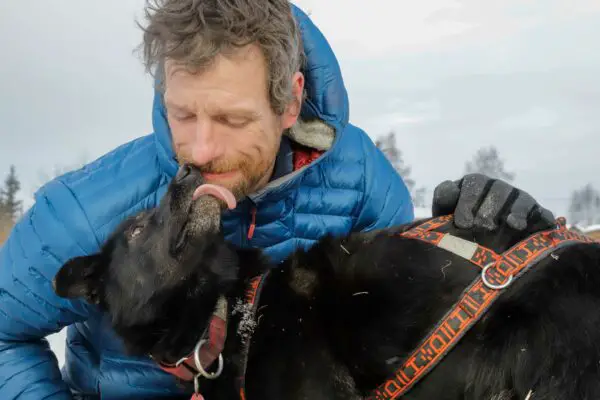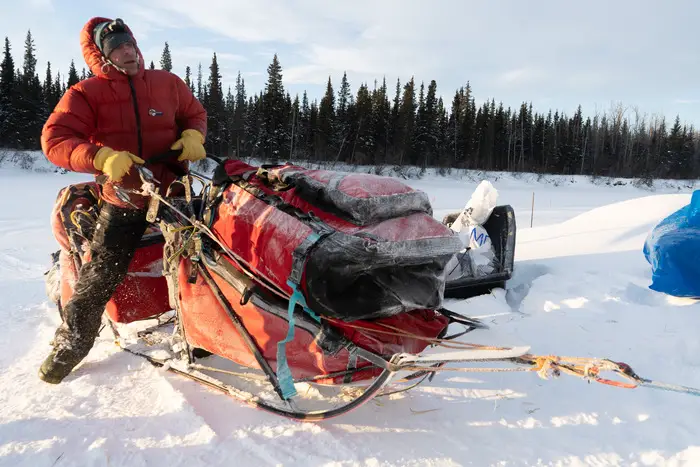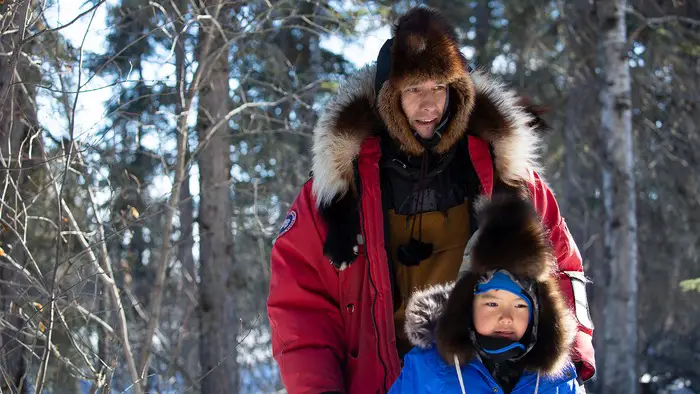Jessie Holmes trudges through the snow towards his truck, nestled deep in the wilderness of Brushkana, Alaska, nearly 30 miles from his cabin. Living in this remote stretch of the Denali Highway for years, Holmes is accustomed to the isolation, especially during winter when heavy snowfall blocks the main road.
In this desolate landscape, Holmes and his team of 42 dogs are the primary inhabitants, making human encounters rare occurrences. Today, a bitterly cold Tuesday with temperatures plunging to -20 degrees, Holmes prepares his team of 12-14 dogs to embark on the journey to retrieve his truck.
Bundled against the biting cold, Holmes guides his sled through the pristine snow, relying on his loyal dogs to pull the load. Despite the harsh conditions, Holmes presses on, navigating the frozen terrain with determination born of years of experience in Alaska’s unforgiving wilderness.

Having reached the parking lot where his truck awaits, Holmes swiftly loads up the dogs and gear before setting off towards Cantwell, a neighboring town. Despite the long journey already undertaken, there’s still work to be done. The task ahead at the lodge in Cantwell beckons, demanding Holmes’s attention and dedication. With his trusty team by his side, Holmes pushes forward, ready to tackle whatever challenges lie ahead.
After indulging in a hot shower, replenishing his energy with much-needed rest, and centering himself through meditation, Holmes releases his dogs to frolic and play. Meanwhile, he meticulously sews caribou fur onto each dog’s harness, not only as a form of meditation but also to enhance their comfort for the journey ahead.
With preparations underway, Holmes gears up for the upcoming challenge: the Iditarod, a grueling 900-mile dog sled race from Anchorage to Nome, beginning the following day. As a native of Sylacauga, this will mark his seventh participation in the race, yet this year carries a distinct significance for him. Each previous race has only strengthened his dedication to the sport, reinforcing his resolve to push himself to the utmost limits.

“He expressed satisfaction witnessing the culmination of their collective efforts on such a grand platform,” he remarked.
For Holmes, aged 42, the odyssey to the Iditarod originated over 4,000 miles away in Phenix City, Alabama, where a troubled youth harbored a sense that there must be more awaiting him.
Holmes hailed from Sylacauga but spent his formative years an hour and a half away in Columbus, Georgia, and Phenix City. Delving into his upbringing isn’t a topic he readily delves into, aside from acknowledging its challenges: growing up with a single mother, enduring bullying, and eventually leaving high school.
“That’s all behind me now,” he stated. “I’m fully focused on what lies ahead.”
Holmes occasionally reflects on his roots in Alabama, particularly his bond with his grandfather, Gene Richmond, a Korean War veteran who served as a paternal figure and ignited Holmes’ enduring passion for wildlife.
“He epitomized a love for nature and animals,” Holmes fondly recalled.
Even before establishing his kennel in Alaska, Holmes harbored a profound affection for animals, especially dogs. Before his Alaskan endeavors, he would care for strays, often sharing stolen food with them in the woods.
Despite his upbringing, Holmes always felt a pull toward something beyond Alabama. Inspired by the film “Jeremiah Johnson,” featuring Robert Redford as a mountain-dwelling trapper, he sought his adventure in the mountains, driven by a quest for something greater.
For a brief period, Holmes found employment with a couple residing in Dawson City, located in the Yukon territory. It was during this time that he encountered a neighbor who was deeply immersed in the world of dog sledding. Instantly captivated by the sport, Holmes swiftly developed a profound passion for it.
“I just fell head over heels for the lifestyle,” he reminisced. “The bond with the dogs, the vastness of the wilderness—it all spoke to me.”
It wasn’t until several years later that Holmes entertained the idea of embracing dog sledding himself. Initially romanticizing the notion, his perspective shifted after his first race, where he finished last. It would be four years before he entered another competition.
“I had to really ask myself, ‘Is this the path I want to pursue?'” he recalled.
Holmes emphasized the considerable financial commitment required for dog sledding, likening it to many other sports. For instance, preparing for a race like the Iditarod could demand up to $100,000 for a kennel of dogs, sleds, and equipment. Determined to pursue his passion, he embarked on a journey of rebuilding, seeking guidance from mentors like Rocky Riley, a seasoned dog musher and brother of Iditarod participant Jerry Riley. Holmes first crossed paths with Rocky Riley 15 years prior, during a cross-country trip along the Yukon River.
“He simply adores the lifestyle—living along the river, nestled in the woods,” remarked Riley.
“Dog sledding just naturally fits into that way of life.”
In 2015, everything shifted for Holmes when National Geographic approached him to join “Life Below Zero,” a documentary series showcasing individuals in Alaska immersed in subsistence living. These individuals push themselves in the wild, relying on their skills to sustain themselves through hunting and building. For Holmes, this opportunity marked a turning point, as it provided him with the financial means to realize his dream of dog sledding.
“For the first time, I was able to earn a living by simply living my life, not by construction work or yard maintenance,” Holmes explained.
“I used that income to chase after my dreams.”

In 2018, Holmes made his debut in the Iditarod race, securing an impressive seventh-place finish and clinching the coveted Rookie of the Year Award. Completing the race in nine days, 23 hours, 39 minutes, and 40 seconds marked a significant achievement for him.
Lew Freedman, a renowned sports writer and former sports editor of the Anchorage Daily News who covered the Iditarod extensively from 1984 to 2001, emphasized the profound significance of the race within Alaska. He highlighted how deeply intertwined the sport is with the state’s history and its transportation legacy.
“The Iditarod is deeply rooted in Alaska’s history and its mode of transportation,” Freedman explained.
“Even today, with vast stretches of land lacking roads, dog sleds remain a crucial means of travel.”
Freedman underscored the grueling mental and physical challenges inherent in the race. From sleep deprivation to managing one’s energy while ensuring the well-being of the dogs, mushers face a rigorous test of endurance. He recounted instances of mushers battling delirium induced by the extreme cold, with some experiencing hallucinations.
“There are tales of mushers dozing off on the sled or even falling off, left behind by their team,” Freedman added.
Freedman emphasized that the Iditarod holds a special place of pride in Alaska, serving as a cherished emblem of the state’s identity and unique way of life.
“Alaskans view the Iditarod as a treasured symbol of their state, a reflection of what makes it distinct and exceptional,” he remarked.
During his interactions with Holmes while researching for his book, “Adventures on the Iditarod Trail: Fast Dogs, Freezing Mushers, and the Alaska Wild,” Freedman was struck by Holmes’ unwavering dedication to the sport and his ambition to carve out a notable reputation within it.
“He’s left a significant mark and is resolutely determined to emerge as a frontrunner,” Freedman noted. “That’s his aspiration.”
In the years following his debut, Holmes has maintained a presence on “Life Below Zero” while consistently participating in the Iditarod. Additionally, he is an avid ultramarathon runner, typically engaging in around 16 races annually. However, Holmes emphasizes that his deepest passion lies with his dogs.
“When you’re responsible for living beings, your existence revolves around their care,” he explained.
“It’s akin to being a farmer—your commitment is to your land and your animals.”

Riley noticed early on how devoted Holmes was to dog sledding.
“You’ve got to truly love it because it’s a ton of work,” Riley explained.
“You need that passion to keep going. If not, it’s a waste of time.”
However, Riley worries about Holmes living alone in the wilderness and the risks involved.
“Being alone out there can be dangerous, but I think he’s gotten more cautious,” Riley said.
“It’s not like living in the city.”
Holmes’s life revolves around racing, caring for his dogs, and mountain living, leaving little room for anything else.
“He’s had girlfriends try to keep up, but it’s too intense for them,” Riley noted.
Holmes acknowledges the sacrifices he’s made for his dreams, often dealing with loneliness, but he believes it’s worth it.
“I’m focused on what I’m doing right now,” he said.
The Iditarod serves as a chance for Holmes to test himself and push his limits.
“You discover what you’re capable of,” he said.



0 Comments